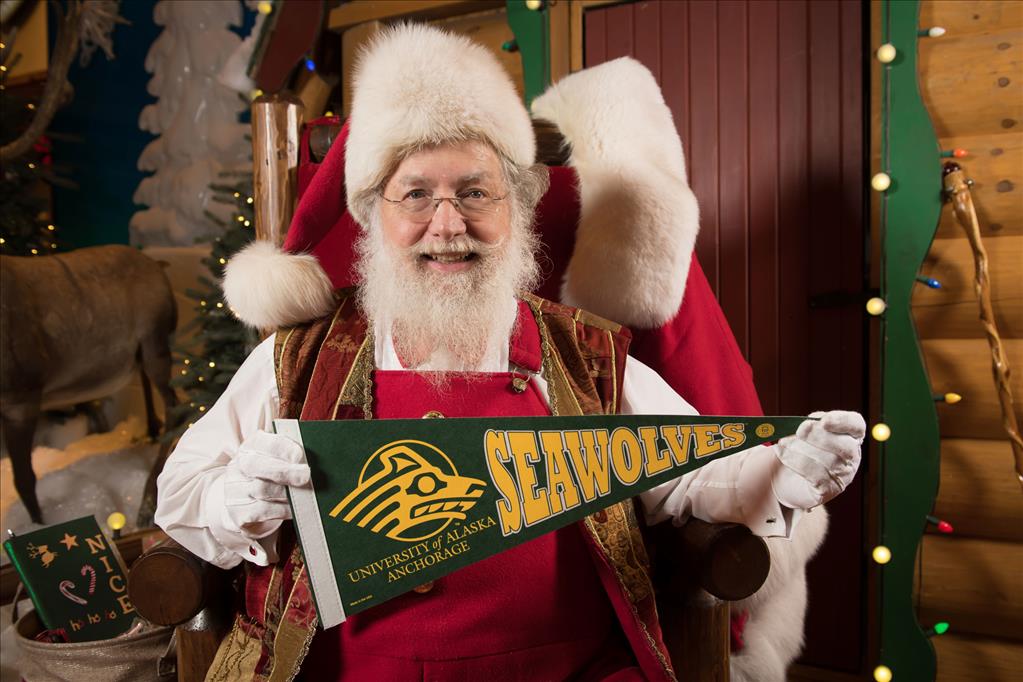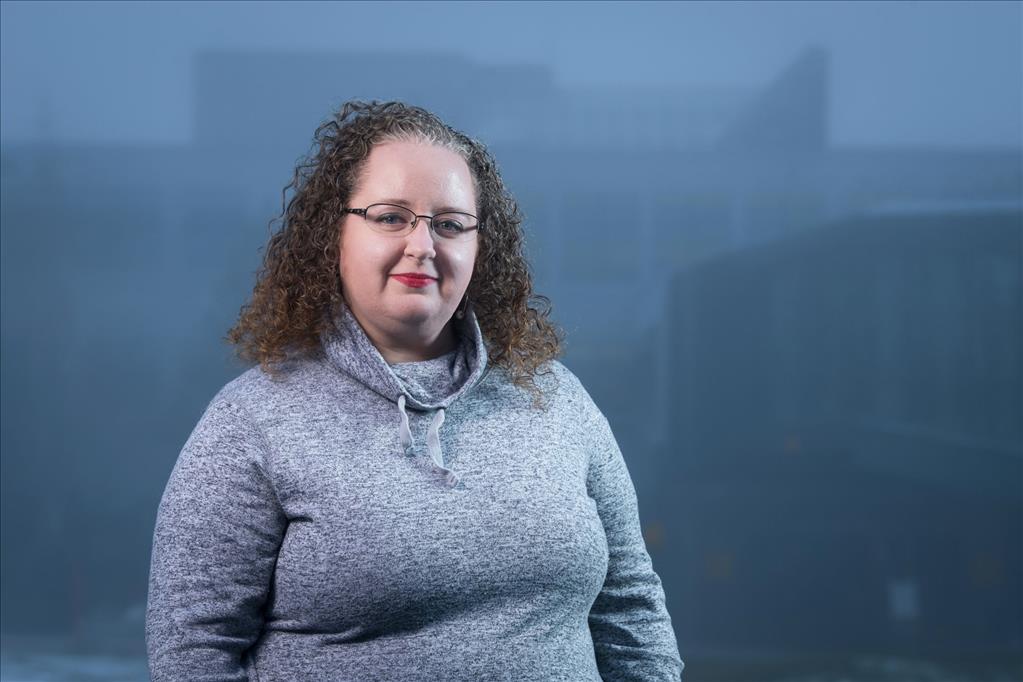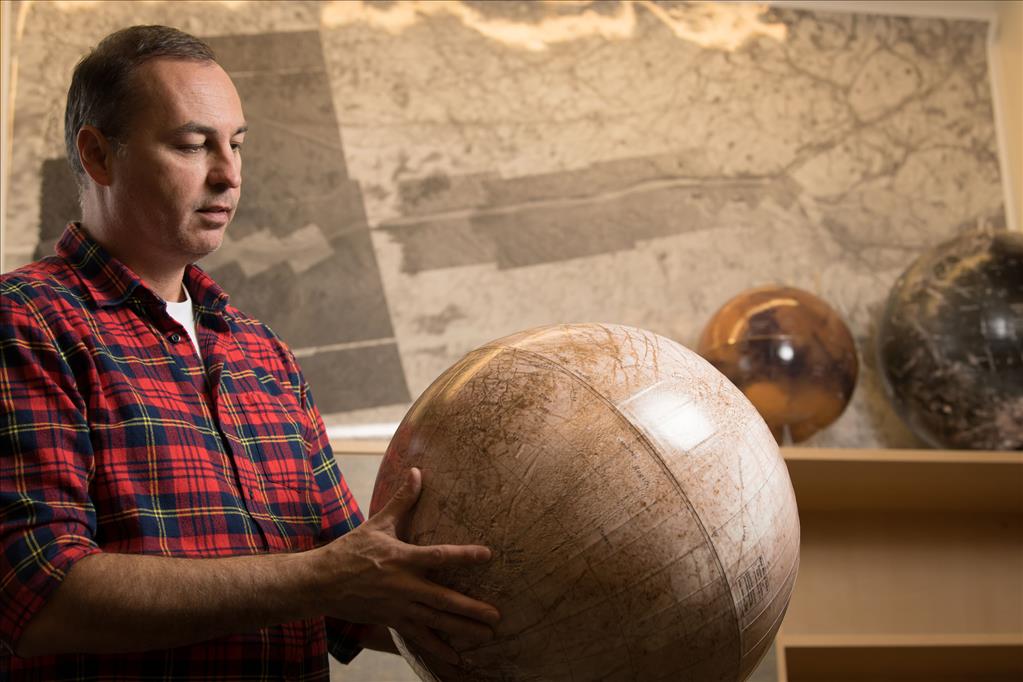Aquarium at the Planetarium
by joey |
Planetariums sound purpose-built for astronomy and stars. But UAA's is a little different.
"It's reflected in the name, Planetarium and Visualization Theater," said Frank Witmer, assistant professor of computer science and engineering. In addition to faculty-presented films, UAA's theater also allows scientists to visualize their findings in an immersive environment, and even hold collaborative meetings under a full-domed projection of their data.
But stats on the ceiling don't make for a compelling presentation. That's where faculty members like Witmer come in. For the past several years, he's taken data from across the Kenai Peninsula - temperature shifts, urban development, elevation models - and used it to create visualizations that show the complex drivers affecting salmon health on the Kenai.
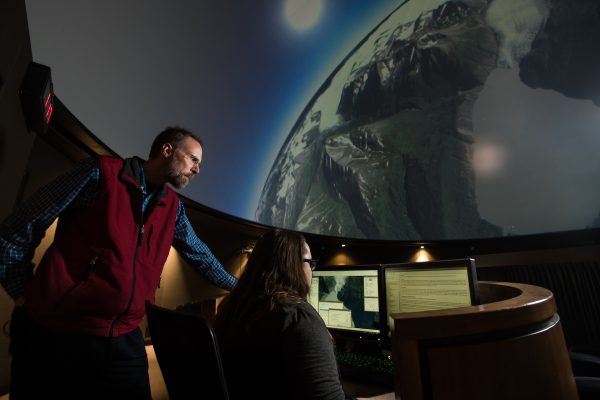
Witmer, standing, zooms in on the Kenai River watershed with the help of Omega Smith, director of the UAA Planetarium and Visualization Theater. (Photo by James Evans / University of Alaska Anchorage).
A computational geographer, with an academic background in math, computer science and geography, Witmer joined UAA in 2014 specifically to visualize results of UAA's EPSCoR grant.
EPSCoR - or, the Established Program to Stimulate Competitive Research - is a National Science Foundation (NSF) grant program that focuses research money on underfunded states (those that netted less than 0.75 percent of total NSF research dollars in the past three years). Alaska was among 24 states and three territories that met the requirements during the last EPSCoR cycle.
The university's current projects study environmental change affecting Alaska communities. UAS faculty are examining glacial recession near Juneau, UAF is studying permafrost thaw in Nuiqsut and the UAA team has studied hydrologic changes in the Kenai River watershed.
The UAA project focuses on six road-accessible communities, and how urbanization, economics, climate and recreation have affected the local watershed, specifically its salmon population. Over the past several years, faculty experts in geography, anthropology, ecology and engineering have monitored water chemistry, measured stream discharge, tracked salmon diet, interviewed fishing guides and even correlated climate conditions to juvenile salmon growth.
With so many angles over so many years of research, the EPSCoR project has churned out a lot of information. Now that the five-year funding window is closing, the goal has switched from collecting data to making it publicly available. And Witmer, along with his colleagues and students, has found several innovative ways to animate the data.
The NSF adds two riders to EPSCoR grants: projects must involve student training, and must be publicly relevant and available. The first request - student research - is easily addressed at a university. The latter - public information - dovetails well with the UAA Planetarium and Visualization Theater's mission, as it was designed for scientists to visualize their data for immersive presentations.
Thus, SalmonSim was spawned. Taking the data collected on the Kenai by faculty and students, Witmer - with the help of a few UAA computer science students, and the Virtual Technology Laboratory at University of Idaho - created a game-ified simulation of the watershed in multiple forms. At its most engaging, users actually navigate the watershed as a virtual salmon, swimming, spawning, building a nest for eggs and passing checkpoints along the way (check it out here). Salmon interact with the virtual environment based on actual climate and behavior data collected by the EPSCoR team.
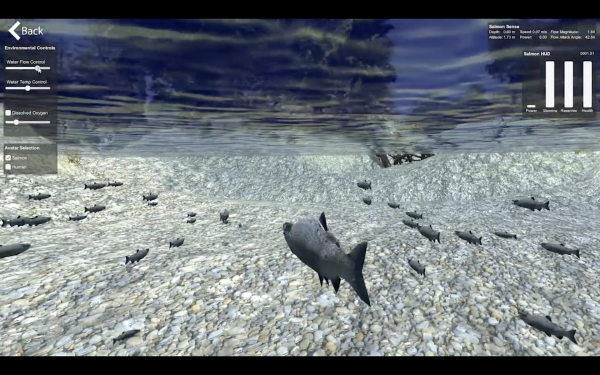
SalmonSim is one of several visualizations Witmer helped create using EPSCoR data. (Screenshot from Virtual Technology Lab / University of Idaho)
Other components are simply visual. There's a side view of the river, much like a glass-walled aquarium, where an instructor can adjust drivers like water temperature and river level to see how it might affect the population. If a company logs the forest, how will all that mud affect the river ecosystem? Viewers experience that change, surrounded by salmon swimming on the ceiling.
With visualized data, the opportunities are immense. But, Witmer joked, "One challenge [of the planetarium] is it doesn't travel well."
With that in mind, he took a sub-project called Salmon 2050 and adapted it to virtual reality headsets, allowing the university's EPSCoR outreach coordinator to bring visualizations to places like Homer, Soldotna and Kenai, where the data matter most.
Salmon 2050 is a storytelling project that imagines how wildlife would respond to five future scenarios on the Kenai, like an industrial boom or a surge in retirement communities. Thanks to programming from Witmer and his student research assistants, participants don a virtual reality headset and find themselves piloting an ATV around the peninsula.
"People get in that immersive visual environment [and see] what it might look like in the future given certain decisions we make today," he explained.
The headsets debuted at UAA's STEM Day in 2017, and have continued to be part of the university's annual celebration of science. The planetarium salmon shows are expected to debut during the theater's 10th anniversary event in January.
"The goal is to have several different movies and content so we can have an additional offering for school and community groups who are interested in ... using that planetarium space," he noted.
The current EPSCoR funding expires this year, but the NSF announced this September that University of Alaska earned another five-year, $20 million grant, this time under the theme 'fire and ice.' The upcoming EPSCoR projects will involve 30 faculty across the state, fund nearly 90 student research positions and, in the end, create another compelling, innovative, creative and relevant visualization for all Alaskans to experience and explore.
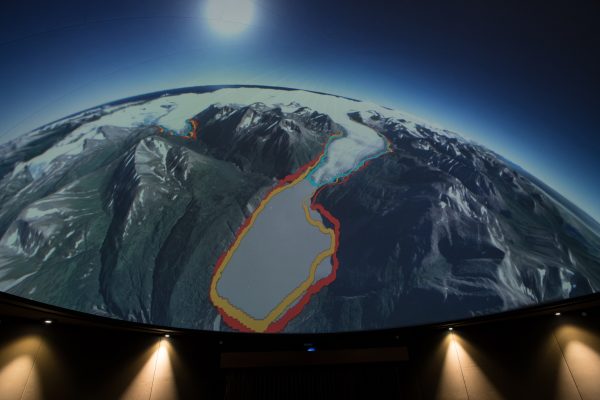
Another Witmer visualization: Skilak Glacier, and its recession since the 1950s. (Photo by James Evans / University of Alaska Anchorage)
Click here to see SalmonSim in action on YouTube.
Click here to read more about University of Alaska's EPSCoR projects, or here for a 3-minute video overview.
Click here to see a list of upcoming planetarium shows (it's not just for planets).
Click here to take an overhead tour of the Kenai Peninsula in another of Witmer's visualizations.
Written by J. Besl, UAA Office of University Advancement
 "Aquarium at the Planetarium" is licensed under a Creative Commons Attribution-NonCommercial 4.0 International License.
"Aquarium at the Planetarium" is licensed under a Creative Commons Attribution-NonCommercial 4.0 International License.











